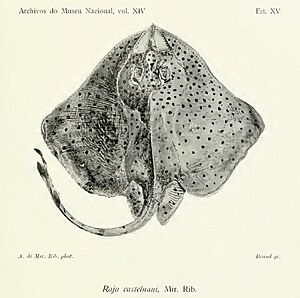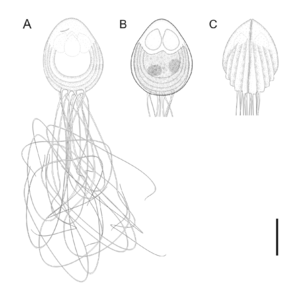Spotback skate facts for kids
Quick facts for kids Spotback skate |
|
|---|---|
 |
|
| Conservation status | |
| Scientific classification |
The spotback skate (Atlantoraja castelnaui) is a type of fish that lives in the ocean. It belongs to the Arhynchobatidae family, which are a group of rays. You can find these skates off the Atlantic coasts of Argentina, Brazil, and Uruguay. They live on the continental shelf in the open sea, which is the shallow part of the ocean floor near land.
Spotback skates are quite large, growing to more than a meter (about 3 feet) long. They mostly eat other fish. They also enjoy shrimp, octopuses, and other small sea creatures. These skates lay their eggs in special capsules that stick to the seabed. Sadly, the spotback skate is caught by fishermen. Many people worry it is being overfished. Because of this, Greenpeace has put it on its "red list" of fish to avoid. The International Union for Conservation of Nature also lists it as an "endangered species". This means it is at high risk of disappearing forever.
Contents
Where Spotback Skates Live
Spotback skates, also known as Atlantoraja castelnaui, live in the Southwest Atlantic Ocean. You can find them from Rio de Janeiro in Brazil all the way down to Argentina. They like warm ocean waters. They usually live at depths from 20 to 220 meters (about 65 to 720 feet).
In Argentina, they are native to the Argentinian Zoogeographic Province. Skates often move to more southern areas when the water there gets warmer. They might move a little bit back and forth depending on ocean temperatures. However, they stay in southern waters all year round.
Even though they still live in the same places, there are fewer spotback skates now. Their numbers have dropped in many areas. Human fishing in their habitats continues to be a big threat to them.
Reproduction and Life Cycle
Male and female spotback skates become mature at different sizes. Males can reproduce when they are between 18.5 cm and 125 cm long. Females are ready to reproduce when they are between 24.3 cm and 136.8 cm long.
Males can produce sperm all year, meaning they can reproduce at any time. Females also reproduce throughout the year. They may have times when they are more active in laying eggs.
Female spotback skates lay their eggs on the ocean floor. They do not stay to care for their young. Instead, the eggs are protected by a strong capsule. This capsule helps the embryo grow inside. These egg capsules are usually rectangular with pointy parts at each corner. They are shiny and medium brown.
The capsules have special sticky threads called adhesion fibrils. These threads help the egg attach to the seabed right after the mother lays it. Other types of skates also have these sticky threads. The outside of the capsule feels a bit rough, but it is mostly smooth. The egg capsules of the Atlantoraja castelnaui are the largest in their group. They are also bigger than eggs from other skate species living in the same ocean areas.
Why Spotback Skates Are Endangered
In cities like Santos and Guarujá, spotback skates are caught and sold. They are popular because of their large size. Since 1999, the market for skate meat has grown. It is now sold in Asia, especially South Korea. This commercial fishing has led to too many skates being caught. Because of this, the spotback skate is now listed as an endangered species.
Spotback skates are very likely to become extinct. This is partly because they are much larger than other skate species. Studies show that larger skate species are more likely to disappear. Being big can mean they have higher death rates. It also means they become mature later in life. Another study found that large body size increases the risk of extinction for sharks and rays.
Spotback skates are also easily caught by trawl fisheries. These are fishing boats that drag large nets along the ocean floor. Skates live on the soft bottom of the ocean, making them easy targets. As a result, the number of spotback skates dropped by 75% between 1994 and 1999.
What Spotback Skates Eat
Spotback skates live across most of the continental shelf all year. They are very flexible eaters. They mostly eat other fish. What they eat can change as they grow bigger. It also changes depending on the season and what food is available.
They mainly hunt for bony fish, octopuses, other rays, and crabs. Smaller spotback skates tend to eat more crabs. Larger skates prefer to eat other rays and octopuses. The type of bony fish they eat changes with the seasons. During colder months, they eat fish that live near the bottom. In warmer months, they eat fish that live right on the bottom. The crabs, octopuses, and rays they eat are mostly shrimp, octopuses, and other skates. Octopuses are a main food source for them in the warm season.
Parasites

Just like all fish, spotback skates can have different parasites. These tiny creatures live on or inside the skates. Some common parasites found in spotback skates include copepods (small crustaceans), nematodes (roundworms), and Myxozoans (a type of tiny parasite).
Sustainable Choices
In 2010, Greenpeace International added the spotback skate to its "seafood red list." This list includes fish that are often sold in stores around the world. These fish have a very high risk of coming from fishing practices that are not sustainable. This means too many are being caught, and their populations cannot recover. Choosing fish not on this list helps protect ocean life.


